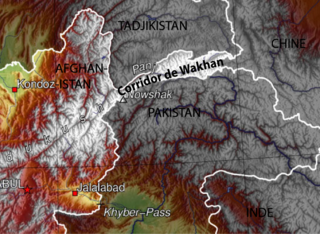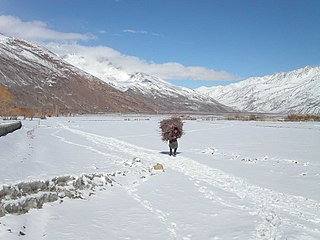
The Amu Darya is a major river in Central Asia and Afghanistan. Rising in the Pamir Mountains, north of the Hindu Kush, the Amu Darya is formed by the confluence of the Vakhsh and Panj rivers, in the Tigrovaya Balka Nature Reserve on the border between Afghanistan and Tajikistan, and flows from there north-westwards into the southern remnants of the Aral Sea. In its upper course, the river forms part of Afghanistan's northern border with Tajikistan, Uzbekistan, and Turkmenistan. In ancient history, the river was regarded as the boundary of Greater Iran with "Turan", which roughly corresponded to present-day Central Asia. The Amu Darya has a flow of about 70 cubic kilometres per year on average.

The Wakhan Corridor is a narrow strip of territory in Badakhshan Province of Afghanistan, extending to Xinjiang in China and separating the Gorno-Badakhshan Autonomous Region of Tajikistan in the north from the northern areas of Pakistan in the south. From this high mountain valley the Panj and Pamir rivers emerge and form the bigger Amu River. A trade route through the valley has been used by travellers going to and from East, South and Central Asia since antiquity.

Broghil, also spelled Broghol, elevation 3,798 metres (12,461 ft), is a high mountain pass along the Durand Line border that crosses the Hindu Kush mountain range and connects Wakhan District of Badakhshan Province, Afghanistan with Chitral District of Khyber Pakhtunkhwa, Pakistan.
Ab Gaj is a village in Badakhshan Province in north-eastern Afghanistan. It is on the left bank of the Ab-i-Wakhan about a mile upstream of the meeting of that river and the Amu Darya, and about ten miles southeast of Kala Panja.
Fotur is a village on the left bank of the Ab-i-Panj river in Badakhshan Province in north-eastern Afghanistan.
Gaz Khan or Goz Khun is a village in the Wakhan in Badakhshan Province in north-eastern Afghanistan. It is located at the confluence of the Panj River and Wakhan River, The village is the starting point for treks into the Great Pamir.
Khandud (Khandut) is a village in Badakhshan Province in north-eastern Afghanistan. It is in Wakhan District, near the left bank of the Panj River.
Langar is a village in the Wakhan District of Badakhshan Province, in north-eastern Afghanistan. It lies on the river Panj, opposite the larger village of Toqakhona in Tajikistan.
Patukh is a village in the Wakhan, Badakhshan Province in north-eastern Afghanistan. Patukh is inhabited by Wakhi people. The population of the village (2003) is 405.
Qalʽeh-ye Panjeh, also written Qila-e Panjeh and Kala Panja, is a village in Wakhan, Badakhshan Province in north-eastern Afghanistan. It lies on the Panj River, near the confluence of the Wakhan River and the Pamir River.
Qazi Deh is a village in Badakhshan Province in north-eastern Afghanistan. It lies on the left bank of the Panj River, 20 km from Ishkashim.
Rokowt is a village in the Wakhan, Badakhshan Province in north-eastern Afghanistan. It lies on the Wakhan River between Qila-e Panja and Sarhad-e Broghil.
Shkhawr is a village in Badakhshan Province in north-eastern Afghanistan.
Sost is a village in Badakhshan Province in north-eastern Afghanistan.

Wakhan River ; known locally as Ab-i-Wakhan or Abe Vâxân, Вахондарё and Vaxondaryo) is the name of the Sarhadd branch of the Panj River along its upper length in the Wakhan District of Badakhshan Province of Afghanistan.

The Wakhjir Pass, also spelled Vakhjir Pass, is a mountain pass in the Hindu Kush or Pamirs at the eastern end of the Wakhan Corridor, the only potentially navigable pass between Afghanistan and China in the modern era. It links Wakhan in Afghanistan with the Tashkurgan Tajik Autonomous County in Xinjiang, China, at an altitude of 4,923 metres (16,152 ft), but the pass is not an official border crossing point. With a difference of 3.5 hours, the Afghanistan–China border has the sharpest official change of clocks of any international frontier. China refers to the pass as South Wakhjir Pass, as there is a northern pass on the Chinese side.

The Little Pamir is a broad U-shaped grassy valley or pamir in the eastern part of the Wakhan in north-eastern Afghanistan. The valley is 100 km long and 10 km wide, and is bounded to the north by the Nicholas Range, a subrange of the Pamir Mountains.
There are several hundred Kyrgyz in Pakistan, most of whom are immigrants based in the northern areas of the country. They have historically inhabited the Gojal valley of Gilgit-Baltistan. Pakistan's Broghil Pass, situated between Chitral and the Wakhan Corridor, also once had a large resident Kyrgyz community. Some hail from the town of Uzgen in the west of Kyrgyzstan; in addition, many were previously settled in the Little Pamir valley of the Wakhan corridor in Afghanistan. They fled to Pakistan in the aftermath of the Afghan Saur Revolution, leaving much of their wealth and animal herds behind.
Broghil Valley National Park is located in the upper northern reaches of the Chitral District, Khyber Pakhtunkhwa, Pakistan, close to the Afghan-Pakistan border.









